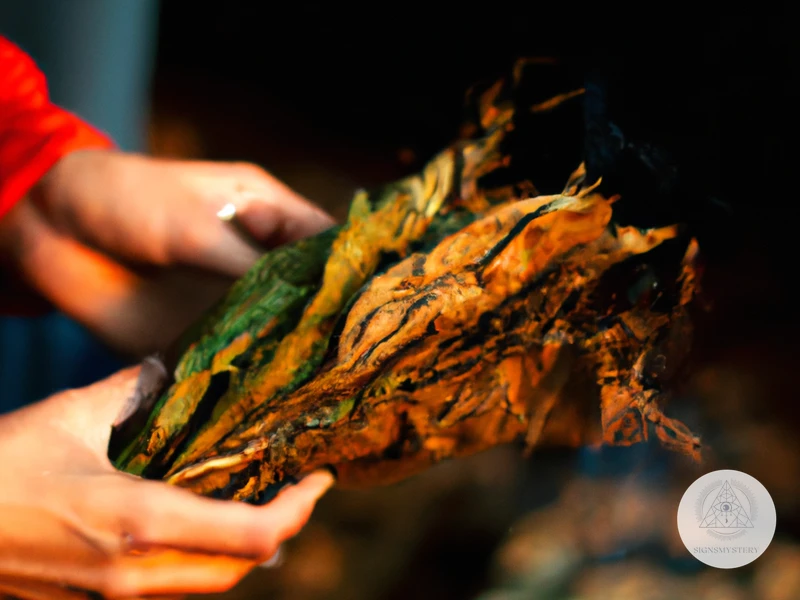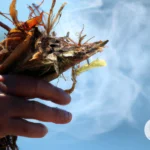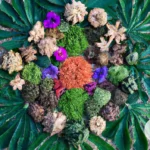Shamanism is a practice that has been present in many indigenous cultures for centuries and is deeply ingrained in their beliefs, rituals, and spiritual practices. One of the most important elements of shamanism is the use of tobacco, which has been regarded as a sacred plant with a multitude of purposes. However, the traditional use of tobacco has been widely misunderstood and often misused, leading to controversy and negative impacts. This article aims to shed light on the traditional use of tobacco in indigenous shamanism, its spiritual significance, types of tobacco used, preparation methods, responsible use, and contemporary issues surrounding the use of tobacco in modern shamanism.
What is Shamanism?
Shamanism is a set of spiritual practices that involves communicating with the spirit world through meditation, rituals, and the use of psychoactive plants. This ancient practice has been a part of many indigenous cultures around the world for thousands of years. Shamans are spiritual leaders who have the ability to connect with the spiritual realm to bring healing, guidance, and protection to their communities. They use various tools like drums, rattles, feathers, and plants to enter into a trance state and connect with the spirit realm. Shamanism is not just a cultural practice, but also a way of life that emphasizes the interconnectedness of all living beings and the importance of living in harmony with nature. If you’re interested in learning more about how plant medicine is used in shamanism, check out this article on Amazonian plant medicines.
What is Tobacco?
Tobacco refers to the plant species Nicotiana tabacum, which is a member of the nightshade family. Tobacco is used in a variety of ways, including for smoking, chewing, and snuffing. In indigenous shamanism, tobacco is considered a sacred plant and is used in ceremonial, healing, and spiritual contexts. Tobacco carries a strong and distinctive aroma and flavor, and it contains a psychoactive substance called nicotine, which stimulates the nervous system. Unlike other plant medicines used in shamanic practices, nicotine is not considered a hallucinogen. Instead, it is seen as a tool for ritual communication, purification, and grounding. Tobacco is commonly used in combination with other plant medicines, such as ayahuasca, San Pedro cactus, psilocybin mushrooms, peyote, cannabis, and DMT.
Importance of Tobacco in Indigenous Cultures
Tobacco plays an important role in the spiritual and cultural practices of many indigenous communities around the world. Its use varies among different cultures, but it is generally used as an offering or a gift to the spirits or ancestors. The plant is believed to have powerful properties that aid in communication and serve as a bridge between the physical world and the spiritual realm.
In many indigenous cultures, tobacco is also used to mark important life events like births, deaths, and coming-of-age ceremonies. It may be offered as a sign of respect or gratitude to elders or used to seal a pact or agreement. Even in modern times, tobacco remains an integral part of many indigenous cultures and is viewed as a sacred plant.
While the importance of tobacco in indigenous cultures cannot be overstated, it is worth noting that the use of tobacco has also been exploited by colonial powers and has been the subject of controversy and debate. Nevertheless, many indigenous communities continue to incorporate tobacco into their spiritual practices and use it as a tool for healing and connection with the divine.
The significance of tobacco in indigenous cultures can be summarized in the following points:
| Description | |
|---|---|
| Spiritual significance | Tobacco is viewed as a powerful tool for communication with the spirits and ancestors. |
| Cultural significance | Tobacco is used to mark important life events and as a sign of respect and gratitude to elders. |
| Sacred plant | Tobacco is a sacred plant that is respected and revered in many indigenous cultures around the world. |
| Controversy and debate | The use of tobacco has been exploited by colonial powers and has been the subject of controversy and debate. |
It is important to approach the use of tobacco in indigenous shamanic practices with sensitivity and respect. By doing so, we can honor the cultural traditions and spiritual beliefs of indigenous communities while also recognizing the medicinal and therapeutic value of plant medicines. For those interested in learning more about the responsible use of plant medicines in shamanism, it may be helpful to explore the resources available on ethics and sustainability in plant medicines in shamanism or plant medicine for mental health and addiction.
The Spiritual Significance of Tobacco

Tobacco holds a deep spiritual and ceremonial significance in indigenous shamanic practices. The plant is regarded as sacred and is often used to communicate with the spirit world and as a purification agent to cleanse the mind, body, and soul. The use of tobacco in healing ceremonies is believed to promote physical, emotional, and spiritual well-being. It is also seen as a gift from the creator and is used to show gratitude and respect. The power of tobacco is not to be taken lightly and it is always approached with reverence and respect. The shaman or ceremonial leader often leads the group in prayers and offerings to honor the plant and its spirit.
Tobacco as a Sacred Plant
The use of tobacco as a sacred plant is deeply ingrained in the traditional practice of indigenous shamanism. In these cultures, tobacco is admired as a holy plant that holds immense spiritual significance.
According to many indigenous beliefs, the smoke produced by burning tobacco creates a bridge between the physical and spiritual world. Tobacco is considered a potent offering to the spirits and is offered as a way to connect with them. The smoke is used to send prayers and messages to the spirit realm, where they can be heard and acted upon.
Tobacco is believed to have immense power and is seen as a protector. It is used to cleanse spaces and to ward off negativity. Many shamans use tobacco in their rituals to create a sacred space and to reinforce the connection they have with the spirits.
While tobacco is considered sacred, it is also regarded with respect and must be used with care and responsibility. Indigenous cultures view tobacco as a gift from the spirits, and as such, they treat it with reverence and honor.
Tobacco, when used with respect and intention, can be a powerful tool for spiritual growth and development in shamanic practice. The sacred essence of tobacco should be recognized and honored by individuals who wish to incorporate it into their spiritual practices.
Tobacco as a Tool for Communication
Tobacco has been used as a tool for communication in Indigenous shamanism for centuries. The act of smoking tobacco is believed to help individuals connect with the spirit world and communicate with ancestors or other spirits. This communication can take many forms, including receiving messages or guidance, sharing emotions, or asking for healing.
There are various ways in which tobacco is used as a communication tool in Indigenous shamanism. Below are some examples:
| Method of Communication | Description |
|---|---|
| Vision Quests | During vision quests, tobacco is smoked to help individuals connect with their spirit guides. The smoke is thought to carry messages to and from the spirit world. |
| Ritual Ceremonies | Tobacco is often used in sacred ceremonies to help individuals communicate with ancestors or other spirits. It is believed that through prayer and tobacco use, individuals can reach a heightened state of consciousness and connect more deeply with the spirit world. |
| Individual Prayers | Some Indigenous cultures believe that smoking tobacco while praying or meditating can help individuals communicate more effectively with the spirit world. The act of smoking is seen as a way of sending one’s prayers or thoughts to the spirits. |
It is important to note that the use of tobacco as a communication tool is taken very seriously in Indigenous shamanism. It is not seen as a casual or recreational activity, but rather as a way of connecting with the spiritual realm. It is essential that individuals approach tobacco use in a respectful and intentional manner.
Tobacco has played a crucial role in the communication practices of Indigenous shamanism. It is believed to facilitate connections with the spirit world and provide a way for individuals to receive guidance and healing. However, it is important to approach tobacco use in a responsible and ethical manner, recognizing its sacred significance in Indigenous cultures.
Tobacco as a Purification Agent
In indigenous shamanism, tobacco is believed to have a powerful purification effect on both individuals and spaces. Tobacco is used as a purification agent in various rituals and ceremonies to cleanse the body and mind of negative energies, allowing the person to connect with their inner selves through spirituality.
When used in ceremonies, tobacco is often burned in a sacred manner and the smoke is used to purify the body and soul. Smudging with tobacco is one of the most common ways used for cleansing and purification. This involves lighting tobacco and blowing the smoke over the individual’s body or into a problematic area. This technique is also used to purify a space before a ritual or ceremony takes place.
Tobacco is also used for personal purification, either by smoking or chewing tobacco. The nicotine in tobacco works as a stimulant and helps to cleanse the mind and calm the body, allowing an individual to concentrate more easily and elevate their perception to connect with their spiritual guides.
It is important to note that the use of tobacco as a purification agent is not limited to smoking or chewing. In some cultures, tobacco tea or bath is used to purify the body of unwanted energies and promote spiritual healing.
However, it is crucial to use tobacco in a responsible manner, following the traditional and ethical methods of use taught by the indigenous cultures. Misusing tobacco or using it in a way that disrespects its spiritual significance can result in the opposite effect, causing harm rather than purification.
Tobacco in Healing Ceremonies
One of the most important uses of tobacco in indigenous shamanism is in healing ceremonies. In many cultures, the shaman or healer may blow smoke onto the patient, or the patient may inhale the smoke, as a way to cleanse and purify the body and spirit. This may be done to remove negative energy or entities, or to promote physical healing and well-being.
In some traditions, tobacco is seen as a powerful medicine that can connect the shaman and the patient with spiritual guides and ancestors who can offer guidance and support during the healing process. The smoke may be used to open channels of communication between the physical and spiritual realms, allowing the shaman to diagnose and treat illness that may be caused by spiritual or energetic imbalances.
Tobacco may also be used to help induce trance states in the shaman or patient, which can be helpful in accessing deeper levels of consciousness and gaining insight into the root causes of an illness or problem. This can be a powerful tool for healing emotional and psychological wounds, as well as physical ailments.
It’s important to note that the use of tobacco in healing ceremonies should always be done responsibly and ethically, with respect for the plant and the cultures that have been using it for centuries. Misuse or abuse of tobacco can have serious negative consequences, both for the user and for the broader community.
The use of tobacco in healing ceremonies is a deeply ingrained aspect of indigenous shamanism, with both spiritual and practical benefits for those who seek healing and guidance. It is a testament to the power and wisdom of traditional knowledge, and a reminder of the importance of respecting and learning from the cultures that have developed it over time.
Types of Tobacco Used in Indigenous Shamanism
The types of tobacco used in Indigenous Shamanism vary depending on the region and the specific tribe. Some tribes use natural and organic tobacco, which is grown without any synthetic chemicals or pesticides. Others use ceremonial tobacco mixtures, which are prepared by blending various herbs and plants with tobacco. These mixtures often have specific purposes, such as enhancing visions or promoting healing. However, the commercial tobacco industry has had negative impacts on Indigenous communities, with many tribes facing health issues and addiction. It is important to understand and respect the traditional use of tobacco in Indigenous communities and work towards promoting responsible and ethical use of this sacred plant.
Natural and Organic Tobacco
Natural and organic tobacco is a crucial element in indigenous shamanism and healing practices. It is often considered to be a sacred plant and is believed to hold spiritual and medicinal properties that are not present in commercially produced tobacco. Organic tobacco is grown without the use of pesticides, herbicides, and other harmful chemicals. Natural tobacco, on the other hand, refers to tobacco that is grown and dried without the use of artificial drying processes, preserving the delicate balance of its natural components.
The use of natural and organic tobacco in shamanism is deeply rooted in tradition and has been passed down through generations of indigenous people. In many cultures, tobacco is seen as a gift from the Creator and is used to establish a connection with the spiritual world. It is usually used as a smudge in sacred ceremonies. The smoke it produces is believed to carry prayers and offerings to the spirits and ancestors.
This type of tobacco is also used in healing ceremonies, often in combination with other sacred plants. It is believed to have powerful medicinal properties that can cleanse the body, mind, and spirit of negative energies and harmful influences. In some cultures, it is even used as an offering to the gods in exchange for blessings and protection.
It is important to note that the use of natural and organic tobacco in shamanism should be treated with the utmost respect and reverence. Indigenous cultures that use this plant hold it in high regard and consider it to be a sacred gift. The use of this tobacco should be approached with humility, mindfulness, and gratitude.
The use of natural and organic tobacco is a sustainable and eco-friendly choice, compared to commercially produced tobacco that is often associated with deforestation, pollution, and other negative environmental impacts. By choosing natural and organic tobacco, we are also supporting indigenous communities and their traditional way of life, helping to preserve their cultures and heritage.
The use of natural and organic tobacco in shamanism holds great significance for indigenous cultures around the world. Its powerful spiritual and medicinal properties make it a valuable tool in healing and connecting with the spiritual world. However, its use should always be approached with respect, mindfulness, and gratitude towards the cultures and traditions that have been passed down through generations.
Ceremonial Tobacco Mixtures
Ceremonial Tobacco Mixtures are a vital aspect of Indigenous Shamanism. Different variations of ceremonial tobacco exist across various cultures. These mixtures are made by blending dried tobacco leaves with other herbs, flowers, or plants and are used in spiritual practices.
Some of the common herbs and plants mixed with tobacco in ceremonial mixtures are:
| Plant | Properties |
|---|---|
| Red Willow bark | Calming, used in meditation |
| Sage | Helps with grounding and cleansing |
| Sweetgrass | Invokes positive energy, used in purification ceremonies |
| Juniper | Provides physical and spiritual protection |
The mixtures are used for various purposes, such as in healing ceremonies, vision quests, prayers, or as an offering to the spirits. Generally, these mixtures are not meant for recreational use and should only be used with respect and intention.
Many Indigenous cultures have specific ways of preparing and using ceremonial tobacco mixtures. For example, in some cultures, the mixture is prepared by a spiritual leader or elder before the ceremony. The elder will offer prayers and sacred songs while blending the herbs and tobacco. In other cultures, the mixture is prepared individually by each participant, with each herb or plant holding a specific meaning or intention.
It is imperative to respect the cultural traditions and practices surrounding the use of ceremonial tobacco mixtures. One should only use these mixtures under the guidance and supervision of a qualified spiritual leader. The disrespectful use of these sacred mixtures can lead to harm and negative consequences. It is necessary to approach the use of ceremonial tobacco mixtures with knowledge, respect, and responsibility.
Commercial Tobacco and Its Impacts
Commercial tobacco is often produced using chemicals that are detrimental to human health. The tobacco industry has been known to use pesticides and harmful additives, such as ammonia and various flavorings, to enhance the flavor and addictiveness of their products. This has led to numerous negative health effects, including cancer, respiratory diseases, heart disease, and other chronic conditions.
Additionally, the commercialization of tobacco has led to the exploitation of farmers and indigenous communities who grow and harvest tobacco crops. These communities often face low wages, dangerous working conditions, and exposure to toxic chemicals.
One of the most significant impacts of commercial tobacco is the cultural disruption and loss of traditional practices caused by its introduction. The mass production of tobacco has led to the standardization of its use and has changed the way many indigenous communities engage with the plant. Traditional ways of cultivating, harvesting, and preparing tobacco have been modified or altogether abandoned in favor of the more efficient and profitable methods used by the tobacco industry.
The rise of commercial tobacco has also led to a decline in the use of natural and organic varieties of tobacco that are often used for ceremonial purposes. The use of commercial tobacco in sacred ceremonies is often seen as inappropriate, as it goes against traditional beliefs and practices.
The commercialization of tobacco has had far-reaching and significant impacts, causing harm to both individuals and communities. It is essential to consider the ethical and environmental implications of the tobacco industry and work towards a more sustainable and culturally respectful approach to tobacco use.
Preparing and Using Tobacco

Preparing and using tobacco in Indigenous Shamanism is a sacred ritual that requires proper knowledge and respect. The traditional preparation methods involve drying and curing the tobacco leaves and mixing them with other herbs or plants to create a ceremonial blend. It’s important to use natural and organic tobacco and to avoid commercial
Subscribe to Our Newsletter
Sign up to receive the latest news and updates.
Traditional Preparation Methods
The traditional method of preparing tobacco for use in indigenous shamanic practices varies depending on the cultural and regional context. In some cultures, the leaves are dried and crushed into a fine powder, while in others, the leaves may be rolled or rubbed between the palms.
One common method of preparation is to wrap the tobacco leaves in a corn husk or a piece of paper, creating a small bundle known as a “tobacco tie” or “tobacco prayer bundle”. These bundles are often used as offerings or as part of personal prayer or meditation practices.
Another traditional use of tobacco in shamanic ceremonies involves the use of a tobacco pipe. The pipe is packed with tobacco and then lit, with smoke being drawn in and then blown out. This is often done as part of a larger ritual or ceremony, and the smoke is believed to carry prayers and intentions to the spirit realm.
In some cultures, tobacco is also used in a form of snuff. The tobacco is pulverized into a very fine powder and then sniffed through the nostrils. This can be a very intense experience, and is often used as a tool for spiritual connection or purification.
Regardless of the method of preparation, it is important to note that the use of tobacco in traditional shamanic practices is often approached with great care and reverence. Tobacco is viewed as a sacred plant, and the act of preparing it and using it is considered a sacred ritual.
Traditional preparation methods are typically handed down through generations and are regarded as an important part of cultural heritage. As such, it is crucial that those who wish to work with tobacco in shamanic practices learn about and respect these traditions and methods.
Responsible and Ethical Use of Tobacco
Responsible and ethical use of tobacco is essential in shamanic practices to honor the sacred nature of tobacco and prevent the negative impacts of misuse.
| Responsible Use | Ethical Use |
|---|---|
| Moderation: Tobacco should be used in moderation, not excessively, to avoid negative effects on the body and mind. The intention of the shamanic practice should be focused on spiritual connection, not addiction. | Cultural Sensitivity: Indigenous cultures consider tobacco sacred and use it with respect and intention. It’s important to approach the use of tobacco in shamanic practices with cultural sensitivity and avoid appropriating traditions without adequate knowledge and permission. |
| Informed Consent: A shamanic practitioner should obtain informed consent from participants before using tobacco in a ceremony. | Sacred Obligation: Some indigenous cultures view the use of tobacco as a sacred obligation that requires a deep level of respect, intention, and discipline. Practitioners should honor this obligation and approach the use of tobacco with reverence and respect. |
| Careful Selection: The type of tobacco used should be carefully selected and of high quality to ensure its purity and safety. | Environmental Responsibility: Tobacco cultivation can have negative impacts on the environment and indigenous communities. Practitioners should ensure that they source their tobacco ethically and support sustainable practices. |
| Cleansing: After the use of tobacco in a ceremony, practitioners should cleanse the space and dispose of the tobacco in a respectful manner. | Intentional Preparation: Before using tobacco, practitioners should prepare it with intention and mindfulness, acknowledging its spiritual significance and power. |
Responsible and ethical use of tobacco in shamanic practices requires a deep level of respect, knowledge, intention, and discipline. Practitioners should approach the use of tobacco with mindfulness, care, and sensitivity to honor its sacred nature and prevent the negative impacts of misuse.
Dangers of Misusing Tobacco
While tobacco has been used for centuries in indigenous shamanic practices, it is essential to note that misusing tobacco can have severe consequences. The dangers of tobacco misuse are vast and can impact physical, mental, and spiritual health.
One of the most significant risks of misusing tobacco is addiction. Nicotine, one of the primary components of tobacco, is highly addictive, and its continued use can lead to a severe dependency on the substance. Tobacco addiction not only affects a person’s health but also their finances, social life, and overall well-being.
Inhaling tobacco smoke can also lead to various respiratory ailments, including lung cancer, chronic bronchitis, and emphysema. Second-hand smoke can also have adverse health effects on those around the smoker, which is why smoking indoors is generally prohibited.
Tobacco misuse can also have detrimental effects on a person’s mental health. Nicotine can cause anxiety, irritability, and insomnia. Tobacco use has been linked to increased rates of mental health conditions, such as depression and schizophrenia.
It is also important to note that using tobacco inappropriately can offend some indigenous cultures and shamanic practices. These cultures view tobacco as a sacred plant and treat it with respect and honor. Using it in an irresponsible or reckless manner can negate the sacredness of the plant and disrespect the cultures that revere it.
It is crucial to use tobacco responsibly and with respect and consideration for both oneself and others. Misusing tobacco can cause significant harm and be detrimental to one’s physical, mental, and spiritual health. It is essential to approach tobacco use with a mindful and responsible attitude to avoid any adverse consequences.
Contemporary Issues with the Use of Tobacco in Shamanic Practices
One of the contemporary issues with the use of tobacco in shamanic practices is the impact of cultural appropriation. It’s important to understand and respect the cultural significance of tobacco in indigenous traditions and not treat it as simply a “spiritual tool” to be borrowed for personal gain. Another issue to consider is the potential dangers of misusing tobacco, as it can have negative health effects when not used in a responsible and ethical manner. Additionally, there are pros and cons to the use of tobacco in modern shamanism, with some arguing that it perpetuates harmful stereotypes and others believing it can be a useful tool in healing and spiritual practices. It’s important to approach the use of tobacco with knowledge, respect, and caution, being mindful of its cultural and spiritual significance.
The Impact of Cultural Appropriation
Cultural appropriation is a growing concern in many fields, including indigenous shamanism. It involves incorporating elements of a culture, often a minority one, into another culture without proper understanding or respect for the original culture’s values, beliefs, and practices. The impact of cultural appropriation in the use of traditional tobacco in indigenous shamanism cannot be overstated.
Cultural disrespect: When non-indigenous people appropriate tobacco use in their spiritual practices without acknowledging the sacred and cultural significance of this plant, it shows a lack of respect for the indigenous communities who view tobacco as a sacred plant. By engaging in traditional practices without proper training or cultural background, it can be easy to unknowingly promote stereotypes and perpetuate negative views of indigenous communities.
Risk of exploitation: Cultural appropriation can greatly contribute to the exploitation of indigenous cultures. Non-indigenous individuals may market traditional tobacco as a tool for their spiritual practices to make profit from the cultural and spiritual wealth of indigenous communities. By oversimplifying and commodifying indigenous practices, tobacco risks losing its spiritual significance and becoming viewed as just another trendy “spiritual tool” that can be easily obtained for profit.
Reinforcing colonial power dynamics: The impact of cultural appropriation in the use of traditional tobacco in indigenous shamanism is also evident in the power dynamics it reinforces. Colonialism has played a significant role in undermining indigenous cultures, and by appropriating indigenous practices, non-indigenous individuals can further contribute to the marginalization of indigenous communities.
It is essential to recognize the impact of cultural appropriation in the use of traditional tobacco in indigenous shamanism. By acknowledging and respecting indigenous cultures and their practices, we can better support indigenous communities and preserve their cultural and spiritual heritage. Ultimately, it is necessary for non-indigenous individuals to seek guidance and education from indigenous communities to ensure that the use of traditional tobacco in shamanic practices is done responsibly and with utmost respect.
The Pros and Cons of Tobacco Use in Modern Shamanism
The use of tobacco in modern shamanism is a topic that raises many pros and cons, both within indigenous communities and outside of them. On the positive side, tobacco can provide a potent aid for people to connect to the spiritual world, as well as to their own inner selves. It can offer a sense of grounding and focus that can be helpful for working with various shamanic practices, such as journeying, divination, or healing.
However, there are also several concerns that surround the use of tobacco in modern shamanism. One of the most pressing ones is the issue of cultural appropriation, as non-indigenous people may appropriate and misuse indigenous practices, including the use of tobacco. This disrespect for indigenous traditions can lead to the commodification and exploitation of sacred plants and cultures, perpetuating further harm and damage to indigenous communities.
Another concern is the health impact of tobacco use, especially in the form of commercial cigarettes. Smoking tobacco can cause numerous health problems, such as lung cancer, heart disease, and respiratory issues. Additionally, commercial tobacco products are often laced with harmful chemicals and additives, which can further exacerbate these health problems.
The overuse or misuse of tobacco can also lead to spiritual imbalance and disharmony, rather than the intended sense of connection and healing. Unethical or irresponsible use of tobacco can lead to dependency and addiction, which can further harm individuals and communities.
The use of tobacco in modern shamanism can yield numerous benefits, but it is also a topic that raises important concerns and challenges. It is crucial for practitioners to approach the use of tobacco with respect, responsibility, and ethical considerations, while also acknowledging and addressing the impacts of tobacco use on both physical and spiritual levels.
Conclusion
In conclusion, tobacco has played a significant role in indigenous shamanism for centuries. It is considered a powerful plant with spiritual and healing properties. The traditional use of tobacco has been a means of connecting to the spiritual world, facilitating communication with ancestors, and purifying the body and mind.
However, the commercialization and misuse of tobacco have led to negative consequences for indigenous communities and individuals. The promotion of smoking as a recreational activity and the cultural appropriation of indigenous sacred practices have contributed to the degradation of tobacco’s spiritual significance.
It is important to acknowledge the cultural and spiritual significance of tobacco and to respect its traditional use in indigenous communities. Responsible and ethical use of tobacco can help preserve its sacredness and prevent harm to individuals and the environment.
As modern shamanic practices continue to evolve and incorporate various elements from different cultures, it is crucial to approach the use of tobacco with caution and respect. The proper preparation and use of tobacco should be learned from trained and experienced indigenous shamans.
Overall, the use of tobacco in indigenous shamanism offers a unique perspective on spiritual and healing practices. By understanding its significance and using it responsibly, we can gain a deeper appreciation for this powerful plant and its role in indigenous cultures.
| Pros | Cons |
|---|---|
| Facilitates communication with spiritual world | Commercialization and promotion of smoking |
| Purification agent | Cultural appropriation |
| Sacred plant | Misuse leading to negative consequences |
Frequently Asked Questions
What is the traditional use of tobacco in indigenous shamanism?
Traditional use of tobacco in indigenous shamanism varies among different tribes, but it is often used for spiritual, medicinal, and ceremonial purposes.
Is tobacco considered a sacred plant in indigenous cultures?
Yes, tobacco is considered a sacred plant in many indigenous cultures around the world for its spiritual and healing properties.
How is tobacco used as a tool for communication in shamanic practices?
Tobacco is often used by shamans as a way to communicate with spirits and ancestors during ceremonies or rituals.
What are some of the types of tobacco used in indigenous shamanism?
Some of the types of tobacco used in indigenous shamanism include natural and organic tobacco, ceremonial tobacco mixtures, and commercial tobacco.
What are the traditional preparation methods for tobacco in shamanic practices?
Traditional preparation methods for tobacco often involve drying and grinding the tobacco leaves, mixing them with other herbs or plants, and then smoking or using them in other ceremonial ways.
How is tobacco used in healing ceremonies?
Tobacco is often used in healing ceremonies to help remove negative energies and promote physical, emotional, and spiritual healing.
What are the dangers of misusing tobacco in shamanic practices?
Misusing tobacco in shamanic practices can lead to addiction, health problems, and negative spiritual experiences.
What are some of the contemporary issues with the use of tobacco in shamanic practices?
Some of the contemporary issues with the use of tobacco in shamanic practices include cultural appropriation, commercialization, and the impact on public health.
What is the responsible and ethical use of tobacco in shamanic practices?
The responsible and ethical use of tobacco in shamanic practices involves respecting the sacredness of the plant, using it in proper ceremonies and rituals, and not misusing or abusing it.
How can non-indigenous individuals respectfully engage in shamanic practices that involve tobacco?
Non-indigenous individuals should seek guidance and permission from a qualified shaman or indigenous elder, educate themselves about the cultural significance of tobacco, and approach the practice with humility and respect.










